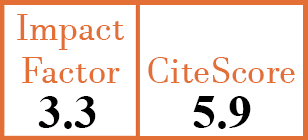Full Papers
Drug survival and predictor factors for discontinuation of first-line biologic therapy in rheumatoid arthritis: data from a real-world single-centre study
O. Katsouli1, P. Orfanos2, V. Lainis3, P. Katsouli4, G. Kapellos5, P.G. Vlachoyiannopoulos6
- Department of Pathophysiology, Medical School, National and Kapodistrian University of Athens, Greece.
- Department of Hygiene, Epidemiology and Medical Statistics, School of Medicine, National and Kapodistrian University of Athens, Greece.
- Department of Pathophysiology, Medical School, National and Kapodistrian University of Athens, Greece.
- Department of Paediatrics, National and Kapodistrian University of Athens, Aghia Sophia Children's Hospital, Athens, Greece.
- Haematology Department, Athens Medical Center, Athens, Greece.
- Department of Pathophysiology, Medical School, National and Kapodistrian University of Athens, Greece. pvlah@med.uoa.gr
CER18308
2025 Vol.43, N°7
PI 1235, PF 1244
Full Papers
Free to view
(click on article PDF icon to read the article)
PMID: 40371548 [PubMed]
Received: 06/11/2024
Accepted : 03/02/2025
In Press: 08/05/2025
Published: 09/07/2025
Abstract
OBJECTIVES:
To evaluate the survival of the first biological disease-modifying anti-rheumatic drug (bDMARD) in a Greek rheumatoid arthritis (RA) cohort and determine factors influencing drug retention rates.
METHODS:
Patients from the Pathophysiology Clinic of LAIKON University Hospital who received their first bDMARD were stratified into anti-tumour necrosis factor (anti-TNF) and non-anti-TNF groups, and whether an event occurred. An event was defined as discontinuation due to inefficacy or adverse event (AE), including severe infections. Drug survival curves were calculated using the Kaplan-Meier method. Analysis was performed using t-tests, chi-square tests, and Cox proportional hazards in STATA, with a 5% significance level.
RESULTS:
We included 724 patients, mostly females (79%), with a median age of 48.6 ±15.7 years at diagnosis. More than half were positive for RF and/or ACPA, with a baseline DAS28-ESR of 4.9 ±1.5. The most used anti-TNFs were etanercept (n=261), infliximab (n=177), adalimumab (n=148), while rituximab (RTX, n=40) was the most used non-anti-TNF. RTX recipients experienced one-half of the events compared to those in the anti-TNF group (IRR 0.52, 95%CI: 0.27 to 0.92). After 276 months, 223 patients discontinued treatment due to inefficacy and 187 due to AEs. Most withdrawals (73.3%) occurred within the first 50 months regardless of cause. RTX was found to be protective against treatment failure, while both RF and ACPA positivity were identified as potential risk factors for discontinuation due to either failure or AE.
CONCLUSIONS:
Only 26.7% of patients remained on first bDMARD after 50 months, with those receiving RTX less likely to discontinue for any reason. RF and/or ACPA positivity could be potential risk factors for discontinuation due to AEs or inefficacy.


